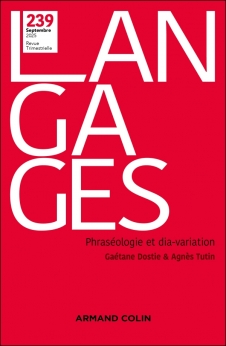
LANGAGES N° 239 (3/2025)
Pour acheter ce numéro, contactez-nous
Recevez les numéros de l'année en cours et accédez à l'intégralité des articles en ligne.
Cette étude se consacre à la variation et l’évolution diachronique des étiquettes nominales rentrant dans la construction phraséologique ‹have the N to› en anglais à partir du corpus diachronique COHA (1820-2010). Au total, 44 % des occurrences de ‹have the N to› correspondent à un schéma phraséologique avec déterminant défini figé renvoyant à un commentaire métapragmatique sur l’attitude. La classification des occurrences de ce schéma phraséologique est affinée en fonction du type sémantique des étiquettes nominales et de la valeur métapragmatique, confirmant que la construction ‹have the N to› a une densité sémantique importante vis-à-vis des 47 noms de parties du corps (npc) observés. L’étude de la variation diachronique des npc dans le corpus tend à confirmer l’hypothèse du renforcement dysphémique à partir des années 1970.
This empirical study aims to examine the variation and diachronic evolution of nouns within the phraseological construction ‹have the N to› in English, using the diachronic COHA corpus (1820-2010). 44% of the occurrences of the ‹have the N to› pattern are found to correspond to a phraseological structure with a fixed definite determiner, referring to a metapragmatic comment on attitude. Using the variation of items filling the N slot and the type of metapragmatic comment implied to analyse the phraseological pattern over time in COHA, it is confirmed that ‹have the N to› carries significant semantic density with respect to the 47 observed body part nouns. The diachronic variation of body part nouns in the corpus tend to confirm the hypothesis of dysphemistic reinforcement starting in the 1970s.